The best way to observe a public space is to simply sit in it. That’s what William “Holly” Whyte, the famed urban sociologist and analyst, did in New York City’s plazas back in the 1970s with a slew of research assistants. They took time lapse films, countless photos, and interviewed passerby in an attempt to decipher user trends and preferences. These days spent in parks and plazas informed Whyte’s many books, including The Social Life of Small Urban Spaces (a key fixture in most modern-day Urban Studies curriculums), and inspired a movement towards public space revitalization. It was Fred Kent, one of Whyte’s research assistants, that would go on to found Project for Public Spaces in 1975—and so here we are today.
While there are now “smart” parking meters that calculate fare based on peak-time demand and e-mail survey blasts to keep track of the changing cityscape, modern plaza analysis methods remain remarkably straightforward, old-fashioned even. The so-called technology needed to observe a plaza include a camera, a clipboard, and a cheerful attitude with which to survey plaza users.
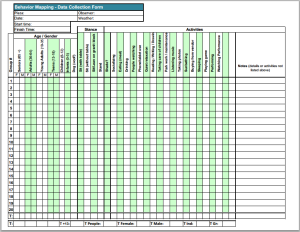
The classic plaza audit, which I used.
This week, armed with these tools, I followed in the legacy begun by Whyte to analyze some plazas on my own. The NYC Department of Transportation has commissioned 27 new plazas in the past year in an effort to create a more livable city, and PPS was brought on to evaluate the effectiveness of these additions. My destination was Marcy Plaza, a bustling street-corner in Brooklyn smack between Bedford-Stuyvesant and Crown Heights. The neighborhood is historically African-American, but social and economic demographics are changing here as in much the rest of the city.
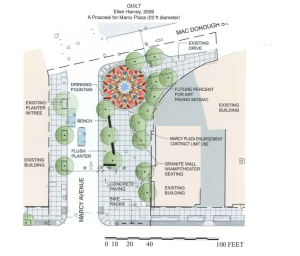
A rendering of Marcy Plaza in Brooklyn.
My task was to stay in the plaza for two blocks of two hours each, taking a behavior mapping audit every 15 minutes and interviewing as many people as I could. The surveys proved more difficult than expected, mostly because of language barriers and because of the plaza’s transience due to its street-corner location. Unlike a quiet neighborhood park, Marcy Plaza lacked a critical mass of “regulars” who shoot the breeze on protected benches all day, away from the street and its rushing traffic.

Marcy Plaza, as seen from Fulton Street.

Western view of Marcy Plaza.
Except, that is, for one extraordinary older gentleman. I came across him early in the morning while he sipped coffee and calmly watched the plaza. He seemed so natural there, it was as if he did this every day—which, as I found out, he did. Our interview was full of skepticism at first—I could tell he didn’t quite trust me, and I did stick out like a sore thumb—but he slowly opened up about not only his well-informed opinions of the plaza but also his 50 years of experiences as “a Brooklyn man!” (his own proud declaration) after emigrating from Barbados.
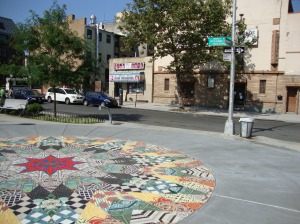
The man’s favorite part of the plaza is this mosaic, which was a recent DOT addition.
The man wouldn’t tell me his name and declined to have his picture taken, but he was a most helpful companion through my whole analysis block, calling people over for interviews and explaining plaza dynamics to me. As the day progressed, I started to feel the plaza’s pulse palpably, in the faces scuttling around and the well-worn benches. It was so clear to me: no technology could record the energy, the peaks and lulls of that plaza better than my own eyes and pen. Despite the specificity of the audits and the tedium they incurred, ultimately they painted an honest and accurate picture of life at Marcy Plaza (and yielded some valuable recommendations for how it could be improved).
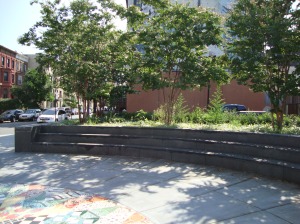
From these steps, I had a great vantage point of the whole plaza.
During a break between sessions, I walked about half an hour to Prospect Park, where I explored the beautiful Brooklyn Botanical Gardens (free on Tuesdays, no less!). When I returned to the plaza for the afternoon session, there was my friend, ready to help out again. Now that’s Placemaking in action: taking ownership of one’s favorite places to make them better for everyone.
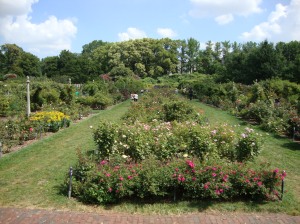
Exploring the Brooklyn Botanic Gardens was such a treat.
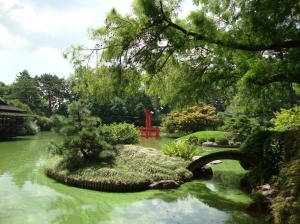
The Japanese Zen Garden at the BBG.
At the end of the day, I shook my friend’s hand, thanked him for all his help, and was rewarded with a formal introduction—as well as his endearing offer to bring me some tomatoes from his garden if I ever came back. And if I ever do return to Marcy Plaza, I’m sure he’ll be there in his favorite public space, sipping his coffee, under the shade of a new umbrella that he himself recommended.








Dear Atomasso, I’m doing a similar survey of the Marcy Plaza and one of my team members found your posting! Would you be willing to share your data with us?